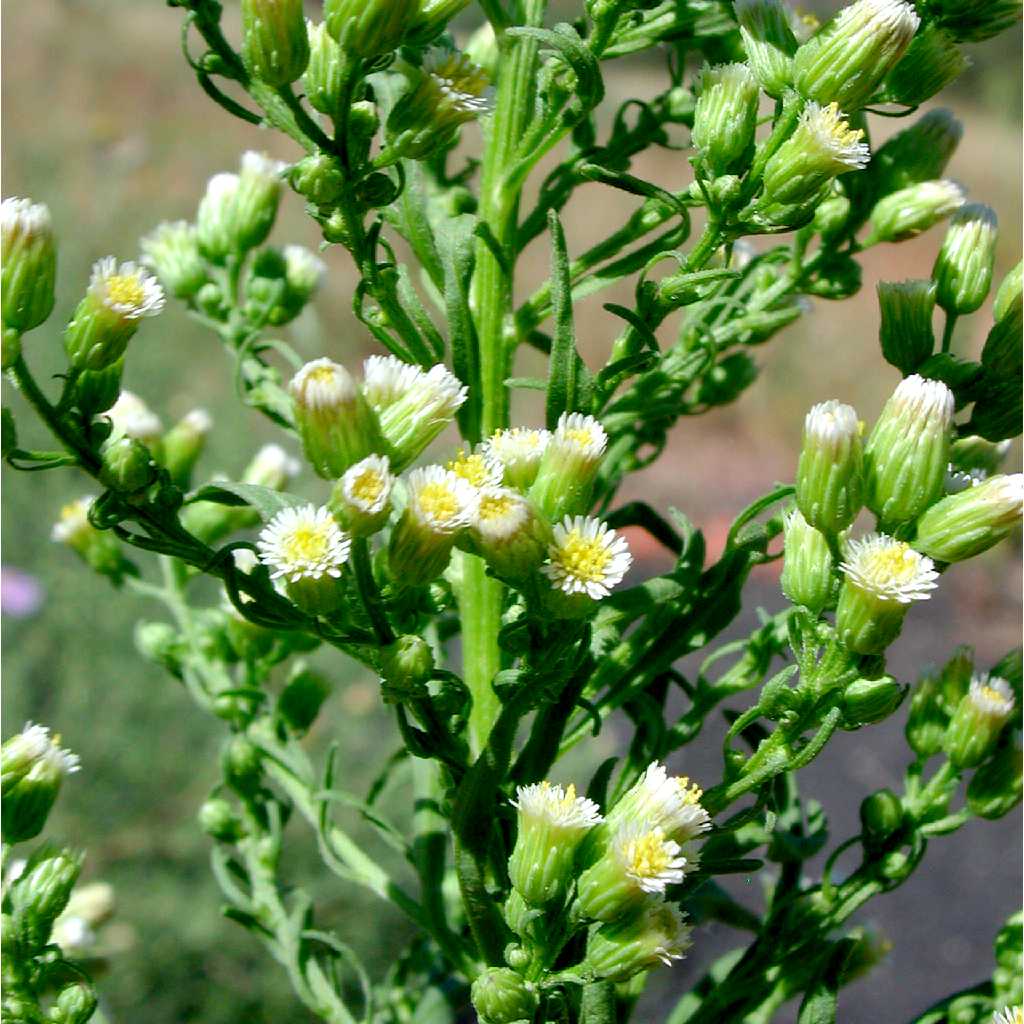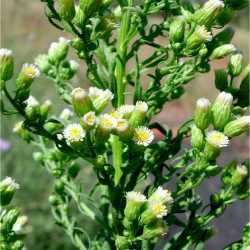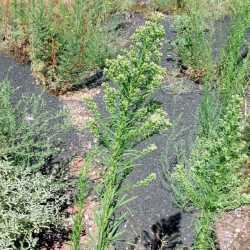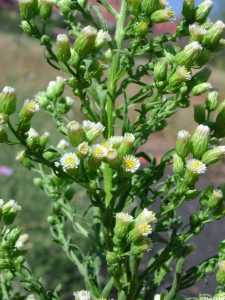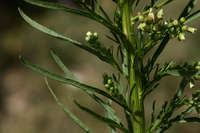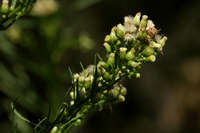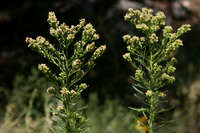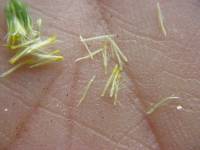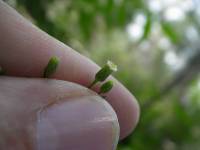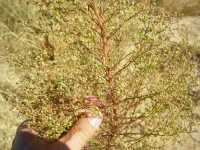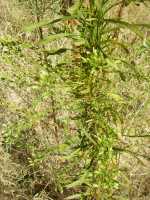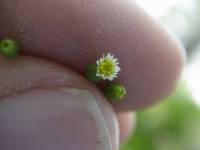Plants erect, (3-)50-200(-350+) cm, branched mostly distally. Leaves: faces usually glabrate (proximal margins ± ciliolate, hairs usually stiff, spreading and hispid on nerves, hairs erect); proximal blades oblanceolate to linear, 20-50(-100+) × 4-10(-15+) mm, toothed to entire; distal similar, smaller, entire. Heads usually in paniculiform, sometimes corymbiform arrays. Involucres 3-4 mm. Phyllaries usually glabrous, sometimes sparsely strigose (margins chartaceous to scarious); outer greenish to stramineous, lanceolate to linear, shorter; inner stramineous to reddish, lance-attenuate to linear. Receptacles 1-1.5(-3) mm diam. in fruit. Pistillate florets 20-30(-45+); corollas ± equaling or surpassing styles, laminae 0.3-1 mm. Disc florets 8-30+. Cypselae uniformly pale tan to light gray-brown, 1-1.5 mm, faces sparsely strigillose; pappi of 15-25, white bristles 2-3 mm. 2n = 18.
Flowering year round, mostly summer-fall. Disturbed places; 0-2000 m; Alta., B.C., Man., N.S., Ont., P.E.I., Que., Sask.; Ala., Ariz., Ark., Calif., Colo., Conn., Fla., Ga., Idaho, Ill., Ind., Iowa, Kans., Ky., La., Maine, Md., Mass., Mich., Minn., Miss., Mo., Mont., Nebr., Nev., N.H., N.J., N.Mex., N.Y., N.C., N.Dak., Ohio, Okla., Oreg., Pa., R.I., S.C., S.Dak., Tex., Utah, Vt., Va., Wash., W.Va., Wis., Wyo.; Mexico; Central America; introduced in South America, Europe, Asia, Africa.
Conyza canadensis is thought to be native to North America and is now widely adventive, e.g., in South America, Europe, Asia, and Africa. Plants with stems glabrous and phyllaries red-tipped are sometimes treated as var. pusilla; similar plants with stems glabrous and phyllaries stramineous (not red-tipped) are sometimes treated as var. glabrata.
This plant bears several other common names, not one of which is applicable to it. It is a frequent to a common weed in cultivated grounds throughout the state. It is also infrequent to frequent in clearings and open woodland. [Deam recognized Erigeron pusillus, a form of Conyza canadensis in which phyllaries have minute purple tips and the stems are almost glabrous.] The only specimen of this fleabane was found on a dune of Princeton fine sand along the railroad about 4 miles south of Vincennes. It is to be noted that on this same dune I have found Stylosanthes biflora var. hispidissima, Carya buckleyi var. arkansana, and two other hickories that I have not been able to name, which apparently belong to the south or southeast.
Duration: Annual
Nativity: Native
Lifeform: Forb/Herb
General: Annual herb, 50-150 cm tall; stems simple below and branched within the inflorescence, glabrous to spreading-hairy.
Leaves: Alternate; lower leaves short-petiolate with oblanceolate blades to 10 cm long; upper leaves sessile, reduced in size, becoming linear; margins serrate to entire, often ciliolate; faces usually glabrate, with stiff, spreading hairs on nerves.
Flowers: Flower heads appearing discoid but actually inconspicuously radiate; many heads arranged in a terminal, open, leafy panicle; involucre (ring of bracts wrapped around the flower head) turbinate, 2-4 mm high, the bracts (phyllaries) in 2-4 series, glabrous to sparsely strigose, the outer phyllaries greenish to straw-colored, the inner phyllaries straw-colored to reddish; ray florets 20-30, the laminae (ray petals) up to 1 mm long, white; disc florets 8-30 or more, the corollas yellow.
Fruits: Achenes about 1 mm long, with minutely stiff hairs, topped with a pappus of white capillary bristles, 2-3 mm long.
Ecology: Found in disturbed soil from 1,000-8,000 ft (305-2440 m); flowers July-October.
Distribution: Throughout N. Amer., in every state in the U.S.; south to S. Amer.; throughout the world on every continent.
Notes: This common, widespread annual weed is identifiable by its solitary, upright, leafy stem which ends in a many-branched leafy inflorescence of numerous small white and yellow flower heads. The leaves are simple, alternate, and narrow, with smooth or toothed margins. If you look closely at the flowers you-ll see that they are radiate, though the ray petals are only about 1 mm long. C. bonariensis is a recent introduction to our region from South America; it appears similar to C. canadensis but has pubescent-hirsute involucres.
Ethnobotany: Used to make an astringent cleanser to treat acne; crushed plant rubbed on sunburns; used as a poultice on temples for headaches; also used to treat earaches, stomachaches, diarrhea, and asthma; raw, pulverized leaves and tender tops used for food, with a flavor similar to onions.
Etymology: Conyza is from the Greek konis (dust), from the use of powdered plants to repel insects; canadensis means of or from Canada.
Synonyms: Conyza canadensis var. glabrata, Erigeron canadensis var. glabratus, Erigeron canadensis, Conyza parva
Editor: SBuckley 2010, FSCoburn 2015, AHazelton 2015
Annual or winter-annual, 1-15 dm, simple or nearly so to the infl; lvs numerous, ±pubescent, or at least coarsely ciliate at the base, oblanceolate to linear, acute, toothed (especially the lower) or entire, gradually reduced upwards, the cauline ones to 8 cm נ8 mm, the basal ones larger and broader but generally deciduous; heads, except in depauperate plants, numerous m a long and open infl; invol 3-4 mm, glabrous or with a few small scattered hairs, the bracts strongly imbricate, brown or with a brown or pale midvein and greener sides; rays mostly 25-40, commonly ca 34, white or sometimes pinkish, 0.5-1.0 mm, equaling or shortly surpassing the style and pappus; 2n=18. A weed in waste places and old fields, throughout the U.S. and s. Can. and to trop. Amer. Late summer and autumn. (Leptilon c.; Erigeron c.) Var. canadensis, our common phase, has the stem coarsely spreading-hirsute, and lacks purple tips on the bracts. Var. pusilla (Nutt.) Cronquist, chiefly along the coast or on the coastal plain, from Conn. to trop. Amer., has the stem glabrous or nearly so, and some of or all the invol bracts are minutely purple-tipped. (Leptilon p.)
Gleason, Henry A. & Cronquist, Arthur J. 1991. Manual of vascular plants of northeastern United States and adjacent Canada. lxxv + 910 pp.
©The New York Botanical Garden. All rights reserved. Used by permission.


